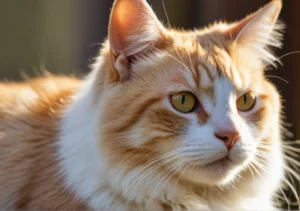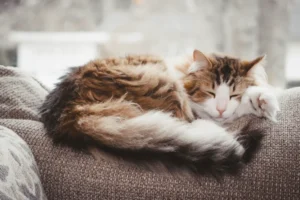Cats have an intriguing way of reacting to various sounds, but one behavior stands out: their response to snapping. Have you ever snapped your fingers, only to see your feline friend perk up and look your way? It’s a curious interaction that many cat owners notice but may not fully grasp.
Cats respond to snapping primarily because it catches their attention. The sharp, sudden sound of a snap can mimic the noises associated with prey or an alert in their environment. This triggers their instinctual curiosity, prompting them to investigate the source of the noise.

What Sounds Attract Cats Most
Cats have a remarkable hearing ability, which allows them to detect a variety of sounds that often go unnoticed by us. High-pitched noises, like chirps or whistles, are especially intriguing for felines. These sounds mimic the calls of birds or small animals, making them instinctively curious.
Moreover, clicking sounds can grab their attention quickly. When you click your tongue or mimic a bird’s call, you may find your cat perk up, ears swiveling in your direction. This is linked to their hunting instincts, as such sounds can signify potential prey.
Felines are also drawn to rustling or crinkling noises, typical of prey moving through grass or foliage. The sound of a treat bag crinkling or a paper being crumpled often draws them in with excitement, anticipating a reward.
Here’s a brief list of sounds that catch the interest of cats: – High-pitched noises (whistles, chirps) – Clicking sounds (tongue clicks or bird calls) – Rustling and crinkling (treat bags, paper) – Soft beeping (like that from electronic toys)
To encourage interaction, try using high-pitched sounds or simulating their prey sounds. It’ll give you insight into how your cat reacts, enhancing your bond.
Do Cats Understand Human Sounds
Felines possess a unique ability to respond to human sounds, but just how well do they understand us? Many owners feel like their cats “get” them, and there’s some truth to that. Cats have been domesticated for thousands of years, and throughout this time, they’ve adapted to our cues and sounds.
While they may not interpret sounds the same way we do, cats can learn to associate certain sounds—like their name or a specific command—with positive outcomes. For instance, if you snap your fingers followed by giving them a treat, they may start to connect the two.
Interestingly, studies suggest that cats respond more to their owners’ voices than to unfamiliar sounds. This connection can be rooted in their social behavior; they might not understand the meaning behind our words, but they can recognize our tone and the context in which we communicate.
Here’s a look at how some typical human sounds can affect cats: – Snapping fingers: Can indicate attention or a playful moment. – Talking in a soothing tone: Often calms them. – Loud noises: May startle them, causing avoidance.
For more in-depth insights into cat communication, refer to ASPCA’s guide on feline behavior.
Ultimately, while your cat may not decipher every sound, they clearly pick up on the energy you put out. So, keep experimenting with your tone and body language; it can lead to a deeper understanding and stronger bond between you both.
How Do Cats Perceive High-Frequency Noises
Cats have an extraordinary sense of hearing, capable of detecting sounds in the high-frequency range—up to 64,000 Hz—which far exceeds the human range. This acute sensitivity is a survival trait, allowing cats to hear the high-pitched calls of small prey or the rustle of a mouse scurrying through leaves.
When you snap your fingers, that distinct sound often falls within that high-frequency range. The snap captures their natural curiosity and instinctive hunting behavior. Cats are hardwired to react to unexpected sounds, and snapping is a quick, sharp noise that cuts through the usual background sounds of the home, making it an effective way to grab a cat’s attention.
Understanding this, if you want to engage your cat, you might also try other high-pitched sounds, like whistling or using certain toys that make noise. Harnessing these sounds can create a fun environment for both you and your feline friend. The next time you snap your fingers, consider how your cat’s well-tuned ears perk up—it’s a connection to their wild instincts.
What Other Actions Capture a Cat’s Attention
Cats are curious creatures, and there are many ways to engage their interest beyond the snap of your fingers. Here’s a quick list of actions that can capture a cat’s focus:
- Rustling Plastic Bags: The crinkling sound mimics the movement of prey, making it irresistible.
- Playing with Light: A simple laser pointer or flashlight can stimulate their hunting instincts like nothing else.
- Bells and Chimes: The ringing of a bell can pique their curiosity, drawing them to investigate.
- Toys with Feathers: The fast movement and fluttering resemble birds, triggering a natural predatory response.
- Whistling: Similar to snapping, whistling often produces sounds that intrigue cats, encouraging interaction.
Spending time engaging your cat through these actions not only entertains them but strengthens your bond. Adding variety to your interactions keeps them mentally stimulated. Keep your cat’s playtime sessions short but frequent to match their natural bursts of energy, and they’ll likely respond more enthusiastically.
For more insights into feline behavior, check out The Humane Society’s guide to understanding cat behavior.
Why Do Cats Respond to Certain Tones
Cats are surprisingly sensitive to pitch and tone, which can significantly influence their responses. They tend to be more attuned to higher-pitched sounds, akin to the noises made by their prey, like birds and rodents. This instinctual reaction is hardwired; when you snap your fingers, the sharp, quick sound mimics a smaller animal’s movement, catching a cat’s attention almost immediately.
Moreover, the emotional component of the sound plays a role too. Friendly tones, when compared to harsh or loud noises, can foster a sense of comfort and security. If you snap with a playful intention, your cat might interpret it as an invitation to engage. Keeping the sound soft and rhythmic can enhance affection, leading to better interaction. You can experiment with various tones to see how your cat responds, building a stronger bond through these auditory cues.
How Snapping Compares to Other Cues
Snapping is just one of many sounds you can use to attract your cat’s attention, but it stands out in a few ways. Here’s a quick comparison against some common cues:
- Snapping: Sharp and quick, resembling prey movements; tends to provoke curiosity.
- Whistling: Familiar but often requires sustained attention; could be playful.
- Calling by Name: A direct approach; effectiveness depends on how well the cat associates its name with positive experiences.
- Rustling Sounds: Mimics the sound of food packaging and can trigger a feeding response.
Each sound has its own impact based on your cat’s unique experiences and preferences. If snapping hasn’t worked for you, consider using a combination of these sounds to see what draws your cat in best.
For an additional tip, pairing snapping with visual cues—like showing a treat—can help reinforce behavior and build a positive association. This combination gives your cat a clearer signal that it’s playtime or time for affection.
Are There Differences Between Breeds
Not all cats are created equal when it comes to responding to snapping. Some breeds seem more in tune with human cues than others. For instance, Siamese and Abyssinians are often noted for their heightened responsiveness, possibly because of their social nature. These breeds thrive on interaction, making them more likely to react to distinctive sounds like snapping.
On the flip side, more independent breeds like the Norwegian Forest Cat or the British Shorthair might not be as responsive. Their aloof demeanor and strong sense of independence can result in a lack of interest in following human cues.
Moreover, a cat’s early socialization plays a huge role. Kittens exposed to various stimuli, including sounds, during their formative weeks are usually more adaptable and aware of human behaviors. Understanding these nuances can be quite beneficial when trying to engage with a cat who may not initially respond to snapping. Tailoring your approach based on your cat’s breed and personality type can enhance communication and strengthen your bond.
Is Snapping an Effective Training Tool
Snapping can actually serve as a surprisingly effective tool in training or behavior modification for cats. It’s a sharp, attention-grabbing sound that many cats instinctively respond to, making it useful for redirecting their focus or encouraging specific behaviors.
Here are some specific ways snapping can be incorporated:
-
Redirecting Attention : If a cat is fixated on something undesirable, like knocking over a glass, a quick snap can draw their gaze to you, breaking their concentration.
-
Positive Reinforcement : Pair snapping with a treat immediately after your cat performs a desired action, like using a scratching post. With time, they might associate the snap with something positive and be more inclined to respond.
-
Alerting to Commands : You can use snapping as a unique marker for commands, similar to a clicker. This can help solidify their understanding of what actions elicit your approval.
-
Setting Boundaries : If your cat is getting too rowdy during play, a sharp snap can serve as an audible cue that they need to calm down.
-
Encouraging Interaction : For more social cats, a snap can capture their attention and encourage them to engage more actively with you.
Experimenting with snapping can complement other training methods, but it’s essential to balance it with patience and understanding of your cat’s behavior. Overusing snapping as a corrective measure might lead to anxiety responses, so moderation is key. For more strategies on training cats, check out The Spruce Pets.
Fun Facts About Cats and Their Hearing
Cats have remarkable hearing abilities , and it’s no surprise they respond to sharp sounds, like snapping fingers. They can detect sounds in the ultrasonic range, up to 64,000 Hz, which is about two octaves higher than humans. This incredible range evolved from their ancestry as hunters. Imagine prowling silently for small prey; being able to hear faint noises gave them a significant advantage.
Interestingly, the structure of a cat’s ear is designed for precision. Their ears are highly mobile, able to rotate independently to pinpoint the direction of sounds. This helps them realize whether that snap is from potential food or a playful engagement—very handy when you’re the size of a small mammal in a vast world.
Here are some intriguing highlights about a cat’s hearing:
-
Highly Sensitive : Cats can pick up sounds at very low volumes. Discussions that seem quiet to us might be loud symphonies to them.
-
Directional Hearing : Their ear muscles allow for a substantial range of motion, helping them locate the source of a sound, which is crucial for survival.
-
Emotion Recognition : Studies suggest cats can respond differently based on the emotion conveyed in our tone, adding another layer to their reactions when they hear snapping.
-
Social Interactions : Cats often respond to certain sounds, like snapping, because it can resemble a sound made by prey or signify communication.
If you want to understand more about your cat’s audial world, check out the American Association of Feline Practitioners for insights on feline behavior: AAFP Feline Behavior Guidance.
Consider using snapping to engage your cat in play. If they perk up or come closer, you may just be fostering their instinctive curiosity.
Alex, a passionate animal lover, has experience in training and understanding animal behavior. As a proud pet parent to two dogs and three cats, he founded AnimalReport.net to share insights from animal experts and expand his knowledge of the animal kingdom.




